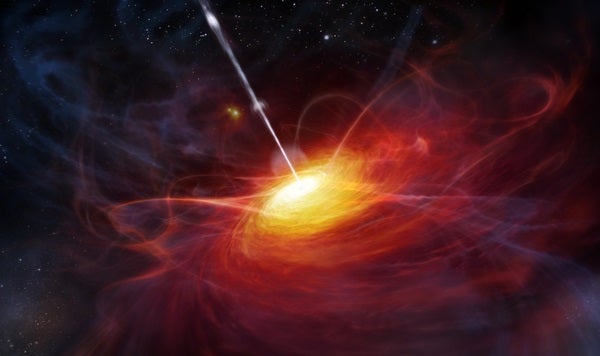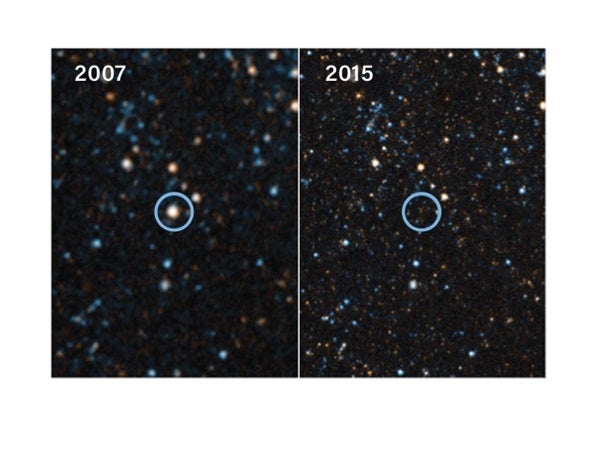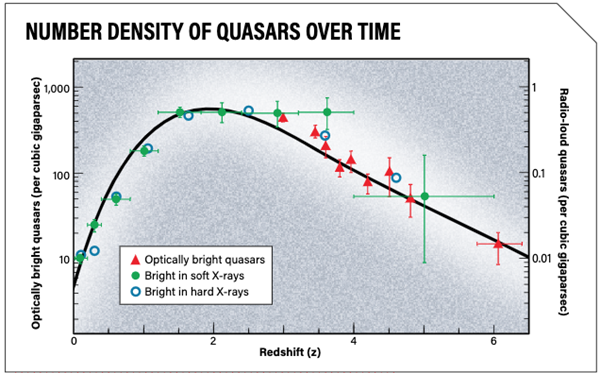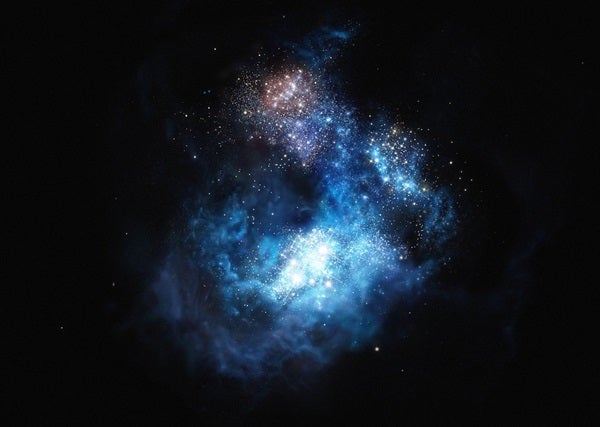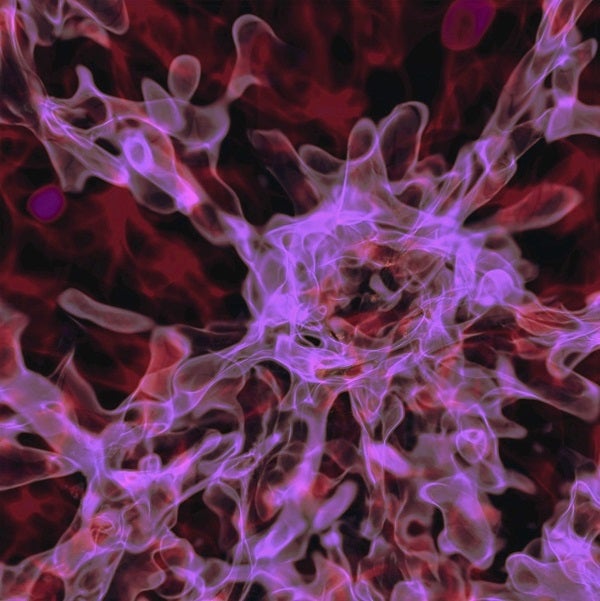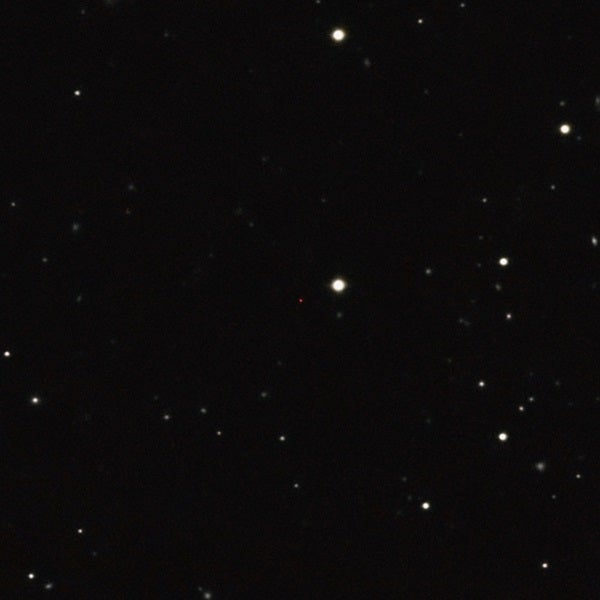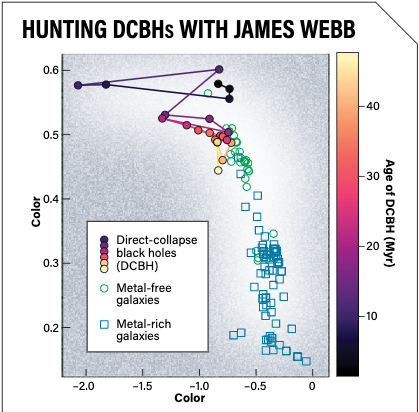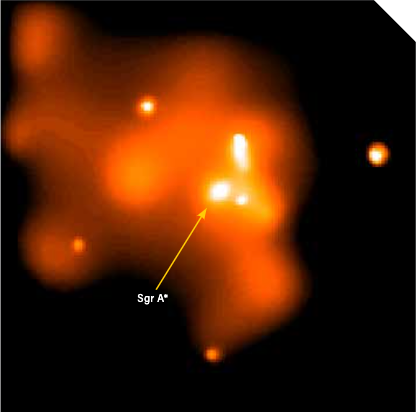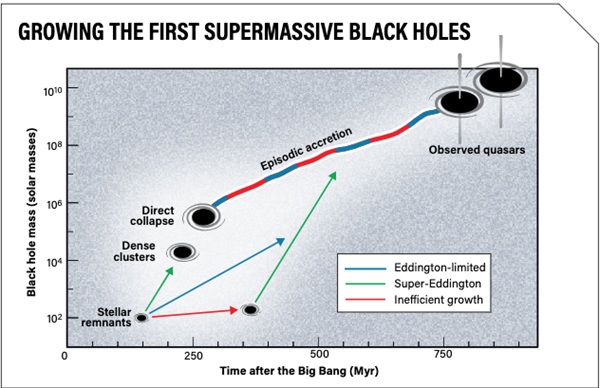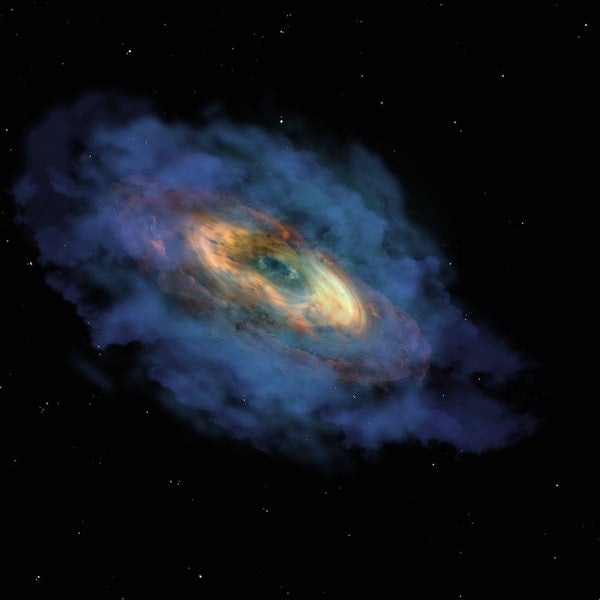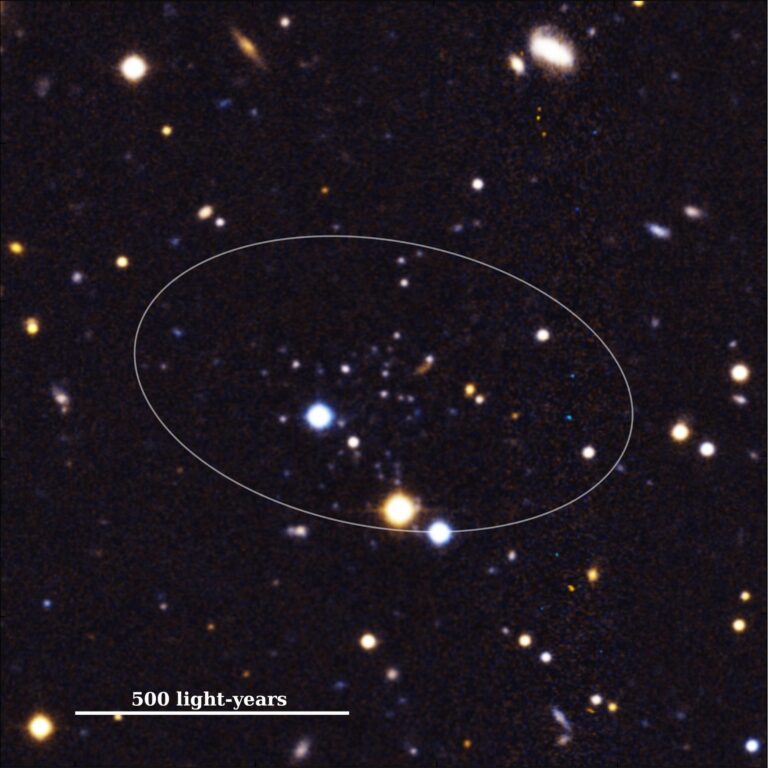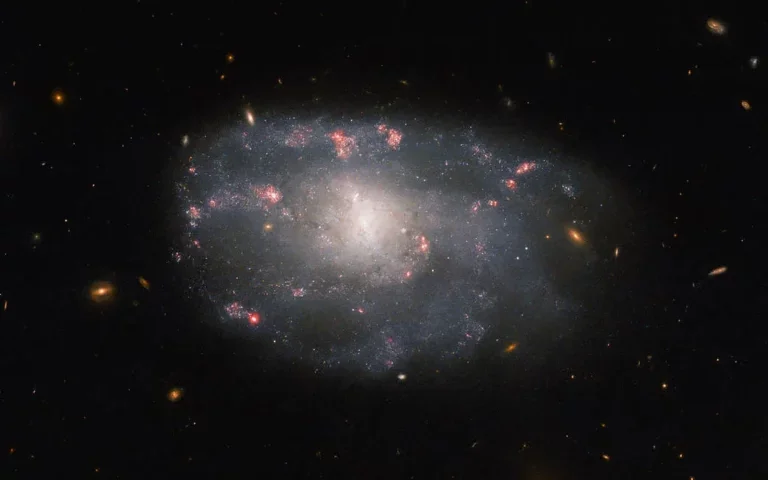In 2017, astronomers started finding monster black holes in the very early universe. Containing roughly a billion times the mass of our Sun, these black holes were surrounded by disks of infalling matter shining so intensely that we can detect them across immense stretches of space and time.
These gravitational giants existed when the universe was only 700 million years old, or 5 percent its current age. At that point in cosmic history, the universe was still a toddler. Gravity was just beginning to rein in clouds of gas and dark matter to form structures that would later evolve into mature spiral and elliptical galaxies. Stars were beginning to pop into being, but they existed in far fewer numbers than they do today.
According to the traditional picture of black hole formation and growth, the universe at this time simply had not existed long enough for black holes to bulk up to a billion solar masses. So, based on our general understanding of how black holes form and grow, these black holes should not exist.
And yet they do — posing a major challenge that astrophysicists have yet to unravel.
High-redshift quasars
Quasars are brightly shining beacons of light and energy generated by the accretion of material onto supermassive black holes. In the 1990s, astronomers using a combination of ground- and space-based telescopes started to find extremely distant quasars powered by black holes of a billion or more solar masses. By the mid-2010s, it was no longer a big deal to find quasars dating back to 1 billion or 2 billion years after the Big Bang. But theorists had a difficult time explaining how such massive black holes could have arisen so soon in the universe’s history.
For quasars and other objects that existed many billions of years ago, it’s meaningless to express their distances in terms of light-years. The universe has expanded so much between then and now that astronomers instead refer to an object’s redshift, which is a measurement of how much cosmic expansion has stretched the object’s light toward redder (longer) wavelengths.
For years, astronomers such as the University of Arizona’s Xiaohui Fan have been identifying quasars at redshifts as high as 6, when the universe was about 900 million years old. They’ve even found a few around redshift 7, which corresponds to an era when the universe was about 735 million years old. But in late 2017, an international team led by Eduardo Bañados of the Carnegie Institution for Science announced a quasar at a record-shattering redshift of 7.54. This quasar, designated J1342+0928 (J1342 for short), based on its sky coordinates in Boötes, was radiating 40 trillion Suns’ worth of energy at a time when the universe was only 690 million years old.
The team found J1342 by mining data from NASA’s Wide-field Infrared Survey Explorer satellite, the United Kingdom Infrared Telescope Deep Sky Survey Large Area Survey, and the DECam Legacy Survey. They used the 6.5-meter Magellan Telescope in Chile to measure the quasar’s redshift, while observations with the 8-meter Gemini North Telescope in Hawaii enabled the team to estimate the black hole’s mass: around 800 million Suns.
“Gathering all this mass in under 690 million years is an enormous challenge for theories of supermassive black hole growth,” said Bañados in the discovery announcement. “The finding shows that a process obviously existed in the early universe to make this monster. What that process is? Well, that will keep theorists very busy!”
Theorists had a difficult enough time accounting for the redshift-6 and redshift-7 quasars. But a supermassive black hole beyond redshift 7.5 borders on the absurd. And, as it turns out, the discovery was not a fluke.
In June 2020, a team with many of the same astronomers, this time led by Jinyi Yang of the University of Arizona, announced the discovery of a second quasar at a redshift greater than 7.5. This quasar, designated J1007+2115, lies at a redshift of 7.515. Its black hole engine weighs a whopping 1.5 billion solar masses at a time when the universe was barely 700 million years old.
Astronomers will likely find even more quasars beyond redshift 7.5 in the future. But probably not many. As Yang says, “The number density of quasars declines very rapidly with increasing redshift.”
If quasars were common beyond redshift 7.5, then astronomers would have found several more by now. But their spatial density — the number of quasars in a given volume of space — appears to be very low, only about one quasar per cubic gigaparsec, where a gigaparsec is 3.26 billion light-years. “You have to survey huge areas of sky to find these objects just because they are intrinsically so rare in the universe,” says cosmologist Joseph Hennawi of the University of California, Santa Barbara. A member of the team that discovered both quasars, Hennawi also helped develop software that makes the discovery of high-redshift quasars more efficient.
That gives theorists some measure of relief. The relative dearth of high-redshift quasars means the conditions that form them are uncommon — i.e., a highly unusual set of conditions can do the trick, creating “seeds” that grow quickly into quasars. As University of Texas at Austin astrophysicist Volker Bromm says, “We only need very few seeds to explain the observed billion-solar-mass quasars at high redshift.”
Still, that is easier said than done.
Slow going
According to the prevailing (and well-tested) cosmological model, known as Lambda-Cold Dark Matter (ΛCDM for short), the universe originated 13.8 billion years ago in the Big Bang. The early universe was initially a nearly featureless cauldron of subatomic particles and dark matter (which outweighs familiar atomic matter by nearly 6 to 1), with material almost evenly distributed and thus unable to clump together into interesting structures.
Crucially, in the first few minutes of the universe’s existence, the prevailing temperatures and pressures enabled subatomic particles to coalesce into hydrogen and helium nuclei, with only the barest traces of heavier elements. When the universe cooled further, 380,000 years later, electrons combined with the hydrogen and helium nuclei, forming neutral atoms and releasing the cosmic microwave background radiation (CMB).
High-resolution measurements of the CMB show that the universe at this time was extremely — but not perfectly — uniform. Subtle irregularities in the density of matter eventually enabled gravity to do its thing. Starting around 200 million years after the Big Bang, regions with slightly greater concentrations of dark matter and gas started collapsing into the first stars and protogalaxies.
But this early era of cosmic history remains out of reach for observers. So to investigate it, theorists perform sophisticated computer simulations, which help tease out what happened as pristine clouds of hydrogen and helium gas gravitationally collapsed. According to calculations, these clouds fragmented into multiple clumps that formed stars with masses up to 500 Suns. These early beacons lived fast and died young, shining with millions of times the energy of our Sun but lasting only a few million years. They died in stupendous supernova explosions, and their cores collapsed into black holes with 100 to 200 solar masses.
These black holes then started devouring nearby material, each like a Pac-Man gone berserk, occasionally even gobbling up entire stars. They probably even merged with one another to form black holes with many hundreds, or perhaps several thousand, of solar masses.
But even the most ravenous black hole could not consume enough material in 500 million years to attain the mass of a billion Suns. That’s because as matter gathers around a black hole, it settles into an accretion disk. Whizzing around the black hole at near-light-speed, the disk heats up and blasts out torrents of radiation across many wavelengths. This intense radiation exerts pressure that literally pushes away nearby matter, limiting how fast the black hole can add mass. An object’s theoretical maximum accretion rate is known as the Eddington limit, after British astrophysicist Sir Arthur Eddington (1882–1944).
Even if a black hole can pull in matter faster than the Eddington limit, that increased accretion should produce powerful winds and outflows that drive material away, choking off further growth. In other words, if episodes of super-Eddington accretion do occur, they are presumably brief in duration, setting yet another limit on how fast a black hole can grow.
Because of these natural limits, astronomers find it difficult to explain how a black hole starting off with 100 to 200 solar masses can accrete enough material in only a few hundred million years to grow into the billion-solar-mass behemoths powering the quasars J1342 and J1007. For that, we need to seed black holes with much higher initial masses. But how are they born?
Direct collapse
It turns out, a model dating back more than a decade offers a potential solution.
In 2006 and 2007, Yale University astrophysicist Priyamvada Natarajan, working with Giuseppe Lodato (now at the University of Milan in Italy), published a series of papers explaining how dense primordial gas clouds (essentially protogalaxies) in the early universe could have collapsed to form seed black holes with masses of 1,000 to 100,000 Suns. Normally, such clouds would have fragmented during the collapse process to form a multitude of massive stars instead of a single black hole. But under certain rare conditions, a few clouds could have collapsed to form extremely massive black holes.
The key to this process is how gas clouds cool. Most of these clouds in the early universe contained a high abundance of molecular hydrogen (H2), which consists of two hydrogen atoms bound together. Natarajan and Lodato found that such clouds will cool quickly, which causes them to fragment into numerous clumps that will each go on to form a star.
But if a small primordial cloud lies close to a much larger protogalaxy that is rapidly forming stars, those stars relentlessly zap the cloud with ultraviolet radiation. This massive input of energy breaks the chemical bonds that bind molecular hydrogen together, converting the cloud into one of almost pure atomic hydrogen (H), which is less efficient at radiating away energy. This gas remains hot, meaning it can’t fragment into clumps that cool and condense to form stars.
Instead, the cloud gravitationally collapses without cooling, ultimately concentrating such a huge amount of mass into such a small volume of space that it forms what Natarajan calls a “direct-collapse black hole,” or DCBH. This process bypasses the formation of traditional stars, although it could form a very short-lived supermassive star.
Natarajan’s simulations show that the DCBHs could have formed with as much as a million solar masses. Such a massive black hole would have quickly merged with the nearby galaxy, where it could have bulked up very rapidly on stars and gas. Natarajan and Lodato originally intended this model to explain ultra-massive black holes — those with masses of 1 billion Suns or more — at slightly lower redshifts. But it also offers a promising solution to the timing problem for the redshift-7.5 quasars by creating seeds massive enough to quickly grow into quasars in a short time.
Natarajan emphasizes that “special conditions” are required to form these DCBHs: a small primordial cloud of hydrogen and helium gas sitting at just the right distance to a much larger star-forming galaxy. This explains why high-redshift quasars are uncommon. “The conditions that you need are pretty stringent to make direct-collapse black holes,” she says. “Those conditions are rare in the early universe, but they are available. Luckily, these monster black holes are very rare, so you can accommodate what is seen so far, easily, without a problem.”
The DCBH model seems to work in a computer simulation. But did such black holes actually form in the real universe?
We shall soon find out. Natarajan says her model can be directly tested in the near future. Even the supermassive black holes that power quasars contain only a few percent of their host galaxy’s total mass. But a DCBH would outweigh the total mass of stars in its small host galaxy by up to 50 times, Natarajan says, creating a bizarre object known as an obese black hole galaxy. (For comparison, the SMBHs at the centers of galaxies in the local universe typically have only 1/1,000 the mass of the galaxy’s stars.) Obese black hole galaxies would be relatively bright at infrared wavelengths, with a characteristic spectrum. “They have a unique signature, so we aren’t going to be confounded with any other kind of peculiar galaxy or object,” she says.
NASA’s James Webb Space Telescope (JWST), currently scheduled to launch in late 2021, should be able to detect DCBHs at redshifts 9 to 12 (when the universe was about NASA’s James Webb Space Telescope (JWST), currently scheduled to launch in late 2021, should be able to detect DCBHs at redshifts 9 to 12 (when the universe was about 526 million to 354 million years old, respectively). And whether it detects these objects will test their model, Natarajan says. “If you grow the black hole from a tinier seed by redshift 9, it would be too faint to be picked up by JWST. So, if the JWST sees any quasar between redshift 9 and 12 … it has to have been a DCBH. We’ll put our neck out there and make that prediction.”
Many mergers
Theorists have come up with other ideas about how the universe could birth the massive seeds of supermassive black holes. A March 2020 paper in The Astrophysical Journal by Lumen Boco, Andrea Lapi, and Luigi Danese of Scuola Internazionale Superiore di Studi Avanzati (International School for Advanced Studies) in Trieste, Italy, mathematically shows how numerous individual black holes formed from massive stars inside a young galaxy can combine to create a SMBH seed.
First, massive stars live out their life cycles, creating many smaller black holes. As these black holes plow through the dense gas within their host galaxy, it creates dynamical friction, or drag, that causes them to rapidly migrate toward the galaxy’s center. There, they can merge to form a single black hole with 10,000 to 100,000 solar masses. This process progresses extremely quickly, taking just 50 million to 100 million years. After that, the researchers said in a press release, the central black hole will grow quickly: “In light of this theory, we can state that 800 million years after the Big Bang, supermassive black holes could already populate the cosmos.”
Boco, Lapi, and Danese note that gravitational-wave detectors such as LIGO/Virgo and the European Space Agency’s upcoming Laser Interferometer Space Antenna mission could detect the rumbles of these ancient mergers.
Going super-Eddington
But there’s yet another way around the growth problem. What if some black holes in the early universe were able to accrete matter at super-Eddington rates for prolonged periods of time? In this scenario, a black hole starting off with a few hundred solar masses could have bulked up relatively quickly into a billion-solar-mass behemoth.
Hennawi, his Santa Barbara colleague Frederick Davies, and other collaborators have recently performed observations suggesting this might have been the case. Using the Magellan and Gemini telescopes, they have measured the amount of light from several redshift-7 quasars by observing how their radiation has ionized the intergalactic gas between the quasar and us.
“We came to the conclusion that the standard picture of black hole growth may actually not apply to these quasars,” says Hennawi. “They’re eating a lot of material but they’re not emitting nearly as much radiation as we thought. They grow so fast that there’s no longer a black hole growth problem.”
Theorists have a difficult time simulating how black holes accrete material. The underlying physics is exceedingly complex, especially for supermassive black holes. But one thing is clear: The presence or absence of magnetic fields, and how they arrange themselves around a black hole, plays a critical role in controlling the rate of the accretion flow.
Magnetic fields thus determine how efficiently a gram of matter radiates light as it spirals toward a black hole. A magnetic field with twists and turns will gum up the flow, causing it to heat up and emit powerful radiation that could stem the infall of material. But, says Natarajan, if the magnetic field takes a direct path and neatly threads an accretion disk, simulations suggest it can whisk material to the black hole, feeding it much faster than the Eddington rate.
If either the direct-collapse or super-Eddington scenario is correct, there is no need to tinker with the ΛCDM cosmological model. And Hennawi points out that it’s not necessarily an either/or proposition. Both direct collapse and super-Eddington accretion could have been operating in the early universe, he says. Natarajan agrees.
Like Natarajan, Hennawi looks forward to the launch and deployment of JWST. Assuming it works as planned, this cutting-edge space telescope will enable astronomers to make measurements of many dozens of high-redshift quasars to see how the energy they produce is affected by the rate at which they accrete material.
“At some level the abundance of ideas is what you really want and need, but the important thing is that we’ll have a lot more understanding of this when we can make these kinds of measurements for a hundred objects,” Hennawi concludes. “That’s really what JWST will allow us to do.”

